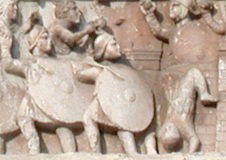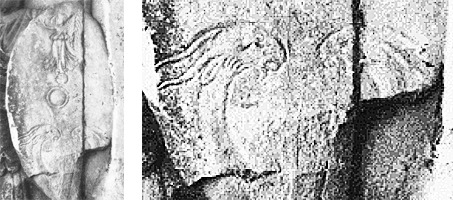
This page created 29 March 2014, and last modified: 26 October (Frankfurt fragment image added)

The Cornuti iuniores is one of the auxilia palatina units under the Magister Peditum in his Italian command. Its shield pattern as shown in various manuscripts is as below:

The pattern shows a green winged Victory (faded to yellow in M) on a white field, encircled in succession by a red band, a violet band (absent in O, M, B, and green in W), a yellow band, and a red rim (pink in M, and thus faded violet?). The patterns is thus very similar to those scribed to the Bructeri and the Felices iuniores Gallicani, which differ chiefly in having a red Victory on a yellow field.
However, it is evident that this is the "wrong" shield pattern; like that of some other western auxilia platina units, it has been shifted from its proper place (or, to be more exact, the label has likely been shifted from its proper place). Rather, the pattern above belongs to the Iovii seniores, and the correct pattern of the Cornuti iuniores is that ascribed to the next unit in the list, the Sagittarii Nervi, as the following patterns taken from the Paris manuscript should help to illustrate:

The various manuscripts show the pattern labelled the Sagitarii Nervi thus:

This shield pattern shows a green ground with a red rim, and, in the centre, a yellow disc bearing a red zoomorphic device that is extremely common in the Notitia (over a dozen examples), especially amongst auxilia palatina - in other words, the shield pattern of the eastern auxilia palatina unit the Cornuti rendered in miniature. Clearly, these two patterns are related.
The name Cornuti is usually taken to mean "the horned ones" (though other etymologies have been advanced). The original Cornuti regiment is believed to have been one of the foremost components of Constantine I's army when he defeated Maxentius in 312, since scholars have seen the central figure shown below (amongst others) on the Arch of Constantine, completed ca. 315, as being a soldier of the Cornuti, due to his helmet decoration. The scene depicts the siege of Verona in 312; these "horns" look more like feathers to me...

This goes back to Andreas Alfoeldi, who in the early 20th century also observed that one of the men on the Arch carries a shield with the following pattern:

A winged Victory stands on a globe above the boss, while below, we see two horned creatures, possibly goats, facing each other, and with their necks curving in towards each other (and interpreted by Michael P. Spiedel in "Ancient Germanic Warriors: Warrior styles from Trajan's Column to Icelandic sagas", Routledge, 2004, as dragons). It may be that this shield pattern represents that of Constantine's original Cornuti regiment, before it was divided into eastern and western divisons.
Nonetheless, this identification with Constantine's Cornuti is far from sure, since it isn't known if this shield depiction dates from the 312-315 construction date of the main Arch like the above figure surely does - this one may have come from another earlier monument like other figures on the Arch are known to have done (although that in itself would be a surprising conclusion).
At some point, the western unit was divided into the seniores and iuniores divisions recorded in the Notitia, but the date is unknown; epigraphic evidence (AE 1977, 806) shows that this had happened as early as 356 for the eastern unit, as an inscription of this date from Nakolea (modern Eskisehir in Turkey) reading NUMERUM IO CORN SEN has been expanded to read the "numeru[s] Ioviorum Cornutorum seniorum"; and this unit can hardly be the western Cornuti seniores, since we know from Ammianus that the western unit was operating on the Rhine in that year. This also implies that the full name of the (western) Cornuti iuniores is likley to have been similarly somewhat longer than the name recorded in the Notitia - something seen with many other epigraphic sources mentioning Notitia units. This inscription is, incidentally, the first mention known of seniores unit - see Thomas Drew-Bear (1977), available here, and disproved the long-held theory that the first iuniores/seniores divisons happened early in Valentianian I's reign, in 364. Recently E.A. Mehamadiev has connected the introduction of iuniores-seniores to the problem of replacing the casualties inflicted in the heavy fighting between Magnentius and Constantius II in the early 350s, and links it with the concerns expressed in the de Rebus Bellicis regarding troop numbers; see E.A. Mehamadiev; Anonymus de Rebus Bellicis and Latin inscriptions from Aquileia: the question of the formation and development divisions seniores-iuniores late Roman army in the 4th C; in Mnemon, Research and publications on the history of the Ancient World; Ed. E.D. Frolova; Issue 13 (2013); p277-291, available here (in Russian).
"The" Cornuti iuniores are themselves mentioned in an inscription (AE 1907,62) from thr Golden Gate in Istanbul giving (in a mixed Latin and Greek inscription) a MILITVM COR[.]VTO[..]M I[.]NIORVM. That the inscription is from Istanbul implies to me however that they might be the otherwise unattested eastern Cornuti iuniores unit, for although no trace of an eastern unit so-named exists in the Notitia, the Nakolae inscription strongly implies that such a unit should have existed. Since the Golden Gate was perhaps built in 413 (when the first of the Theodosian walls was completed) - i.e. after the eastern portion of the Notitia was last amended, the unit must have existed during the time the Notitia was drawn up. But since the western half was last amended after that date, this implies that if the unit mentioned is in fact the western unit, it must have been transferred east later. On the other hand, if the inscription concerns the eastern unit, one must account for its non-appearance in the Notitia. In this regard, it is instructive to recall the first row of the second page of shield patterns accompanying the Magister Militum Praesentalis II is clearly messed up, as is the last row, and there are some other problems as well. It may the the putative eastern Cornuti iuniores ought to be in this command, but has been lost in whatever copying process corrupted the transmission of this command's list of troops and accompanying patterns.

Return to the Notitia alphabetical unit list page.
Return to my Notitia index page.